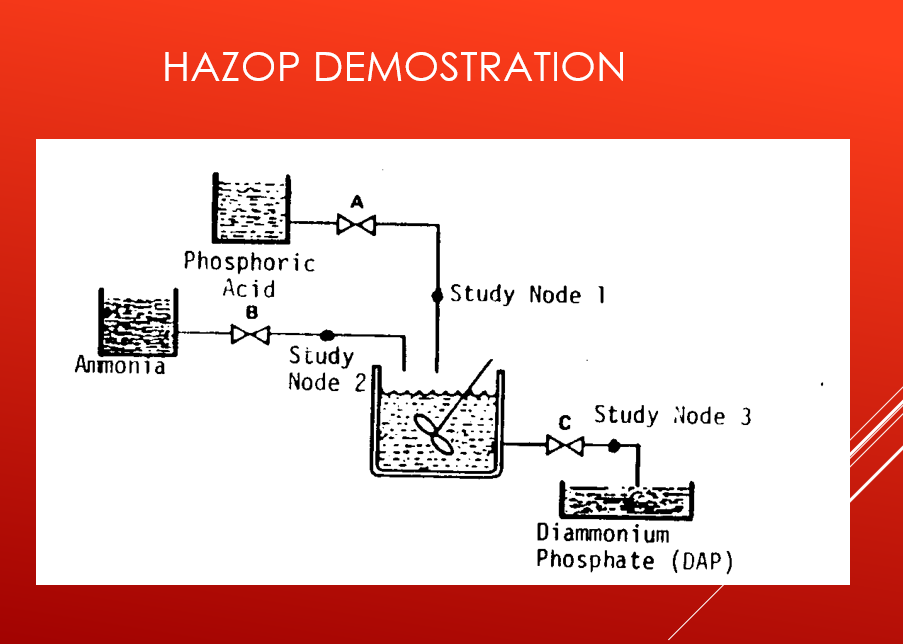BACKGROUD
Initially prepared by Dr H G Lawley and associates of ICI at Wilton in 1960’s.
Subsequently C J Bullock and A J D Jenning from ChE Dept. Teeside Polytechnic under supervision of T.A. Kletz applied the method at higher institution (post-graduate level).
In 1977, Chemical Industries Association published the edited version. ( More focused after Flixborough Disaster in 1974).
ICI Expanded the procedure called HAZARD STUDY.
HAZOP? WHAT DOES IT ADRESS?
Identification of potential hazard/operability problem, IN ADVANCE, Securitization of causes & consequences, application of safeguard.
The primary goal in performing a HAZOP study is to identify, NOT analyze or quantify, the hazards in a process.
The end product of a study is a list of concerns and recommendations for prevention of the problem, NOT an analysis of the occurrence, frequency, overall effects, and the definite solution.
ASSOCIATED TERMINOLOGY
Study Nodes: The locations (on piping and Instrumentation drawings and procedures) at which the process parameters are investigated for deviations.
Design Intent: The intention defines how the plant is expected to operate in the absence of deviations at the study nodes. This can take a number of forms and can either be descriptive or diagrammatic; e.g., flowsheets, line diagrams, P&IDs.
Deviations: These are departures from the intention, which are discovered by systematically applying the guide words (e.g., “more pressure”).
Causes: These are the reasons why deviations might occur. Once a deviation has been shown to have a credible cause, it can be treated as a meaningful deviation. These causes can be hardware failures, human errors, an unanticipated process state (e.g., change of composition), external disruptions (e.g., loss of power), etc.
Consequences: These are the results of the deviations should they occur (e.g., release of toxic materials). Trivial consequences, relative to the study objective, are dropped.
Safeguard: existing provisions to mitigate the likelihood or consequences of the perceived deviations and to inform operators of their occurrence.
Guide words: simple words used to qualify the intention in order to guide and stimulate creative thinking and so discover deviations.
GUIDEWORDS
| GUIDEWORD | MEANING | COMMENTS |
| NO | Complete negation of design intentions | No part of intention is achieved and nothing else occurs. |
| LESS | Quantitative decrease | Quantities and relevant physical properties such as flow rates, heat. |
| MORE | Quantitative increase | Same as above. |
| PART OF | Qualitative Decrease | Some intentions are achieved, some are not |
| AS WELL AS | Qualitative Increase | All design and operating intentions are achieved |
| REVERSE | Logical opposite of intention | Activities such as reverse flow or poison instead of antidote |
| OTHER THAN | Complete substitution | No part of intention is achieved; something quite different happens |
HAZOP REQUIREMENTS
Process flow diagrams
Piping and instrumentation diagrams (P&IDs)
Layout diagrams
Material safety data sheets
Provisional operating instructions
Heat and material balances
Equipment data sheets Start-up and emergency shut-down procedures
HAZOP TEAM
The HazOp team normally comprises between four and eight members, each of whom can provide knowledge and experience appropriate to the project to be studied. All members of the team must have enough technical knowledge and authority to make decisions within their own orbit of responsibility.
Two types of person are required in HazOp team:
Those with detailed technical knowledge of the process
Those with knowledge and experience of the HazOp technique and the ability to chair and report upon technical meetings.
A typical team for a new project comprises:
Chairman or team leader
Secretary
Process design engineer
Instrument & control engineer
Operations specialists Project engineer
Responsibilities of team leader includes defining the scope for the analysis, Selecting HazOp team members, Plan and prepare the study, Chair the HazOp meetings, Trigger the discussion using guide-words and parameters, Follow up progress according to schedule/agenda, Ensure completeness of the analysis.
Responsibilities of secretary include preparing HazOp worksheets, Recording the discussion in the HazOp meetings, Preparing draft report(s).
The presence of engineering experts facilitates a rapid response to actions/recommendations. Some organizations require the presence of a safety specialist, though the chairman may well fill this role.
Other specialists may be consulted or be available for specific points.

HAZOP PROCEDURE
1. Divide the system into sections (i.e., reactor, storage)
2. Choose a study node (i.e., line, vessel, pump, operating instruction)
3. Describe the design intent
4. Select a process parameter
5. Apply a guide-word
6. Evaluate consequences/problems
7. Determine cause(s)
8. Recommend action: What? When? Who?
9. Record information
10. Repeat procedure (from step 2)


Process Unit: DAP production
| Study Node: 1 Process Parameter: Flow | |
| The HazOp team is assigned to investigate “Personnel Hazards from the Reaction”. | |
| Guide Word | Deviation | Possible causes | Consequences | Suggested Actions |
| No | No Flow | 1.Valve ‘A’ fails closed | Excess ammonia in reactor. Release to work area | Automatic closure of valve ‘B’ on loss of flow from phosphoric acid supply |
| 2.Phosphoric acid supply exhausted | ||||
| 3. Plug in pipe; pipe ruptures | ||||
| Less | Less Flow | 1. Valve ‘A’ partially closed | Excess ammonia in reactor. Release to work area, with amount released related to quantitative reduction in supply. | Automatic closure of valve ‘B’ on loss of flow from phosphoric acid supply. |
| 2. Partial plug or leak in pipe | ||||
| More | More Flow | – | Excess phosphoric acid degrades the product. No hazard to work area | – |
| Part of | Normal flow of decreased concentration of phosphoric acid | 1.Vendor delivers wrong material or concentration. | Excess ammonia in reactor. Release to work area, with amount released related to qualitative reduction in supply. | Check phosphoric acid supply tank concentration after charging. |
| 2. Error in charging phosphoric acid supply tank. |
EXTRA COMMENTS
HazOp study is time consuming.
HazOp study is a brainstorming process towards thinking, “What can go wrong?”
In addition to the proposed projects, HazOp study may also be conducted on an existing facility to identify modifications that should be implemented to reduce risk and operability problems.
Focuses on one-event causes of deviations.



